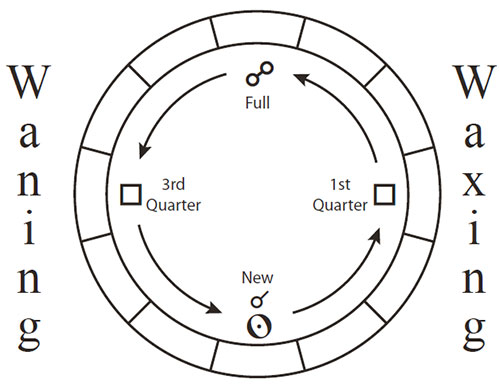In astrology the term waxing is used to designate the half of an orbital or synodic cycle between two planets that begins at the conjunction and ends at the opposition. This is as opposed to the waning phase, which is the half of the synodic cycle that begins at the opposition and then ends at the conjunction.
Waxing and Waning Cycle of the Moon
The concept is most commonly applied to Moon, where the Moon is said to be in her waxing phase or waning phase, although in modern astrology the term has become applied more broadly to the synodic cycles between other pairs of planets as well.
When applied to the Moon, the waxing cycle takes place in the first half of the cycle after the New Moon takes place and then up to when the Full Moon is exact. The waning cycle takes place in the second half of the cycle from the Full Moon up to the New Moon. See the diagram below for an illustration.
The waxing phase corresponds to the half of the Moon’s cycle where it goes from being the darkest at the New Moon, to eventually being at its brightest at the Full Moon. In the Hellenistic tradition the Moon was said to be “increasing in light” during this part of its cycle. The waning phase falls on the opposite side of the cycle, where the Moon goes from being at its brightest to its darkest, and thus it was called “decreasing in light” in ancient times.
Interpretation of the Waxing Phase
Since the waxing phase takes place in the first half of the synodic cycle with the Sun, it is usually symbolically associated with themes like new beginnings, growth, and adolescence. This is contrasted with the waning phase, which is symbolically associated with endings, decay, and maturity.
Within the context of electional astrology the concept is usually applied so that astrologers advise people to initiate things that they want to grow and develop when the Moon is waxing, but initiate things that are meant to decrease and decline when the Moon is waning.
